Streatham Park
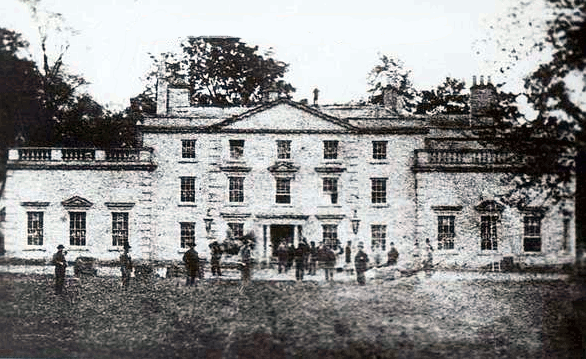
Streatham Park, or Streatham Place, was built in 1730 by Ralph Thrale (1698-1758) on 89 acres of land bought from the local Lord of the Manor - the fourth Duke of Bedford. It was rumoured that the sale price was a ten-year supply of ale and porter for the Duke's home, Woburn Abbey.
Location
The estate was six miles from London on the edge of the common between Streatham and Tooting in a district which then was wholesome, green and rural. In 1811 Streatham's population numbered just 2,729. Around this time, regular coach services commenced to Westminster. By the time of Streatham Park's decline, the population had risen ten-fold. The land that formed Streatham Park is now bounded by Tooting Bec Common to the north, Thrale Road and West Road to the west, and the London to Brighton railway to the east. This area is still known as Streatham Park today. Google map of area »
Grounds, lake and outhouses
The house was in a park of 109 acres. The kitchen gardens, Henry's pride, were surrounded by fourteen feet high brick walls. At the back of the home were farm buildings, domestic offices, large greenhouses, stables, and an ice-house. Behind these and to the west was the kitchen garden with forcing-frames for grapes, melons, peaches, and nectarines. Later the an extensive meadow was created which was separated from the adjoining heavily wooded park by a three acre lake. The lake contained an island, accommodated a boat and drawbridge. In winter the lake was used for skating. The grounds were elegantly planted, with a two mile long circular gravel walk, shrubbery and a ha-ha1.
Building
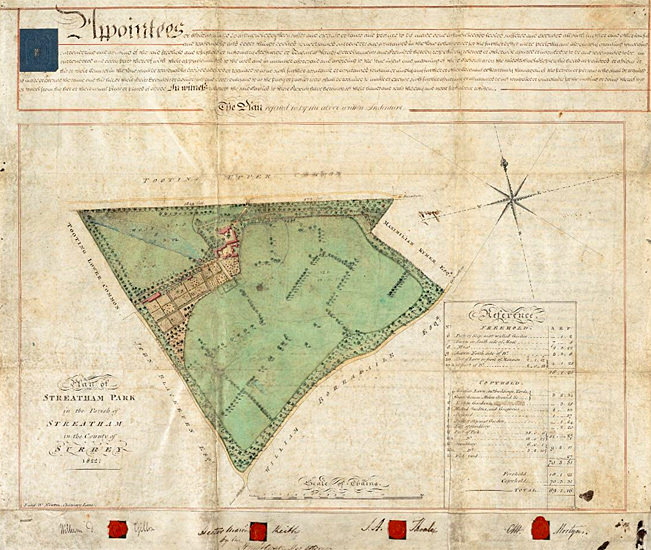
A sweeping drive of a hundred yards led from the lodge gates to a compact three-story brick house. Streatham was a comfortable country house, though far removed from the luxurious mansion it later became; for it then had no spacious parlour or library, no extensive lawn, pond, or summer house. These - together with a white stucco exterior covering - were added as the family and income increased. The house finally consisted of a main central block with a pedimented front; two low extensions, with a balustrade on each side of it.2
Johnsonian connections
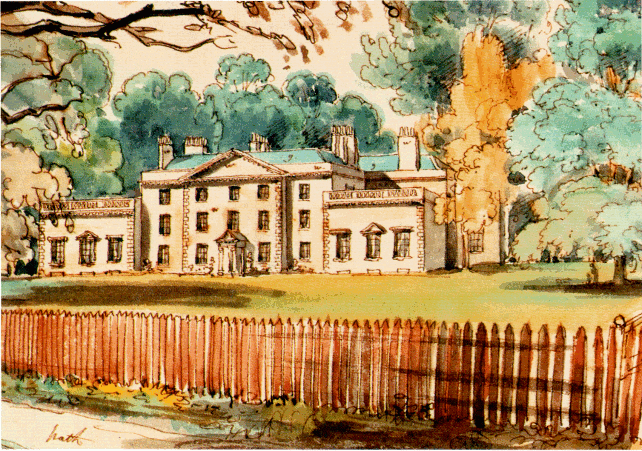 Johnson lived here in his own apartment with the Thrale's almost as part of their family from 1765. On the occasion of James Boswell's first visit on 6th October 1769, Boswell wrote…
Johnson lived here in his own apartment with the Thrale's almost as part of their family from 1765. On the occasion of James Boswell's first visit on 6th October 1769, Boswell wrote…
I found, at an elegant villa, six miles from town, every circumstances that can make society pleasing. Johnson, though quite at home, was yet looked upon with awe tempered by affection, and seemed to be equally the care of his host and hostess. I rejoiced at seeing him so happy.
Henry Thrale's home at Streatham Park became the focal point of the Thrale's social life, and a country retreat for Samuel Johnson, Sir Joshua Reynolds and other distinguished members of Thrale's intellectual and artistic circle. On 24 July 1771 Samuel Johnson asked the builders to leave about 100 loose bricks as…
I can think of no better place for Chimistry in fair weather, than the pump side in the kitchen Garden.
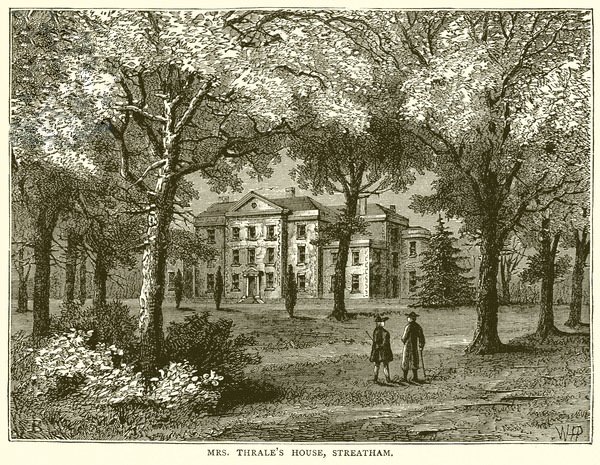
Between 1771-1773 Henry several improvements were made, including the addition of a library and several other rooms. In July 1773, Samuel Johnson's new room - a bow windowed room above the library - was completed. There was also a summer house which was much loved by Samuel Johnson. In August 1777 Mrs. Elizabeth Montagu wrote …
On Wednesday I dined at Streatham … We had a most elegant dinner, and the best of all feasts, sense and wit and good humour. Mrs Thrale is a woman of very superior understanding, and very respectable as a Wife, a Mother, a friend and a Mistress of a Family… Mr Thrale has a fruit garden and a kitchen garden that may vie with the Hesperian Gardens for fruit and flowers.
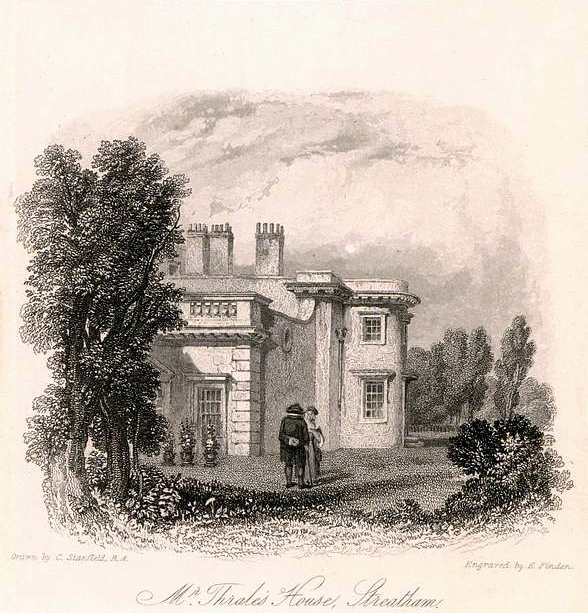
In August 1778, Fanny Burney first visited Streatham. She wrote of this:
August.--I have now to write an account of the most consequential day I have spent since my birth: namely, my visit. Mr. Thrale's house is white, and very pleasantly situated, in a fine paddock. Mrs. Thrale was strolling about, and came to us as we got out of the chaise. "Ah," cried she, "I hear Dr. Burney's voice! and you have brought your daughter?—well, now you are good!" She then received me, taking both my hands, and with mixed politeness and cordiality welcoming me to Streatham. She led me into the house, and addressed herself almost wholly for a few minutes to my father, as if to give me an assurance she did not mean to regard me as a show, or to distress or frighten me by drawing me out. Afterwards she took me upstairs, and showed me the house, and said she had very much wished to see me at Streatham, and should always think herself much obliged to Dr. Burney for his goodness in bringing me, which she looked upon as a very great favour. When we returned to the music-room, we found Miss Thrale3 was with my father. Miss Thrale is a very fine girl, about fourteen years of age, but cold and reserved, though full of knowledge and intelligence.4
 It was at Streatham that Fanny Burney later wrote the verses of the Streatham Flasher in March 1779.
It was at Streatham that Fanny Burney later wrote the verses of the Streatham Flasher in March 1779.
Fanny Burney said5 of Streatham Place:
I know not how to express the fullness of my contentment at this sweet place.
Tenancies
Sometime after Henry Thrale's death in 1781, the Thrale's spent some time in Grosvenor Square. Streatham Park was leased and had new occupants. Prestigiously, the first was Prime Minister Shelburne from September 1782. Streatham Park was leased until 1828, aside from six years between 1790 and 1795 when Hester and Gabriel Piozzi resumed occupancy.
Hester and Gabriel Piozzi
Streatham Park was let until April 1790, after which Gabriel and Hester Piozzi returned. Much damage was done during the seven and a half years during which it had been rented. £2,000 was spent on restoration which was completed by the time of their seventh wedding anniversary when the Piozzi's threw a grand party. The numbers at the party gives some concept of the size of the house. 36 people sat down to dine at a long table in the library, and 12 people were seated for dinner in the adjoining dressing room.
The Piozzi's seventh wedding anniversary
On 28 July 1790 Hester wrote in Thraliana…
We have kept our seventh Wedding Day, and celebrated our Return to this House with prodigius Splendor and Gayety. Seventy People eat at our Expence, Thirty six of which dined at an immensely long Table in the Library6 —The Plate so fine too, the China so showy, all so magnificent, and at the Time of Dinner Horns Clarin &c wch afterwards performed upon the Water in our new Boat that makes such a beautiful, such an elegant Figure. Never was a pleasanter Day seen, nor Weather half as favourable: the Setting Sun, the full moon rising, were wonderfully happy Additions; and at Night the Trees & Front of the House were illuminated with Colour'd Lamps, that called forth our Neighbours from all the adjacent Villages to admire & enjoy such Diversion. Many Friends swear that not less than a Thousand Men Women & Children might have been counted in the House & Grounds, where tho' all were admitted, nothing was stolen, lost, broken, or even damaged—a Circumstance almost incredible; & which gave Mr Piozzi a high Opinion of English Gratitude and respectful Attachment.
Hester's writing about Streatham Park
On 12 October 1790 Hester wrote of Streatham in Thraliana…
On the Morning of this Day twenty seven years ago I first opened my Eyes in this House, to wch my Mother, myself, my Uncle & distant Relation the Rev: Thelwall Salusbury who had married us—were brought by Mr Thrale to reside. And what a House it was then! a little squeezed miserable Place with a wretched Court before it, & all these noble Elm Trees out upon the Common. Such Furniture too! I can but laugh when it crosses my Recollection. Yet how serious and how thankful should every Thought of my heart be, at the Remembrance that every Year has produced some singular Improvement, & that here I am, blessed with Health to enjoy all that has been done by both my Husbands for my Satisfaction and Comfort. Poor Piozzi has sure enough, a little over-done the Business; & put us into a little Distress for Money, to pay these last Bills: which amount to no less than two thousand Pounds.
On 3 January 1791, Hester wrote in Thraliana…
Streatham looks divinely itself; my present Master has been an admirable Steward for my past Mistresses, who I hope will approve his Works, tho’ I'm told they always censure mine. Our Nursery Garden, Shrubbery &c. is in the finest Order I ever yet saw them; & the House has an Appearance of Gayety never attempted in Mr Thrale's Time. Constant Company, elegant, expensive and tasteful Furniture; splendid Dinners and fine Plantations. I am glad that Hanover Square house is let, or going to be Let to Lord Dumfries ; our Establishment here is too magnificent for the admission of other Expences, and if we are prudent even Bath must be given up for this Season, for one cannot do every thing; tho' by Dint of Management I see that a great Deal may be done with 3000£ o'Year. M r Piozzi is a capital Manager.
On 27 January 1791, Hester wrote in Thraliana…
We are going to Bath for the Season, most of our great Debts paid, & our Hearts at Ease: the Servants always plague one I think— but that's of small Consequence.
In Thraliana on 17 September 1791, on Queeney's 27th birthday, Hester Thrale wrote of the improvements at Streatham since her birth 27 years previously in 1764…
Here was then neither Lawn, nor pond, nor Shrubbery without doors; nor Eating Parlour, Drawing Room or Library within—but a little Brick House with four Walls, & there a Gate. The Park divided into Fields or Closes, & all the Pleasure Ground Common.
In Thraliana on 17 April 1795, Hester curiously wrote that her bedchamber at Streatham was 31 of her steps wide and 28.5 long - remember that she was only 4 feet 11 inches tall - while Brynbella's was 26x26 steps.
Decline
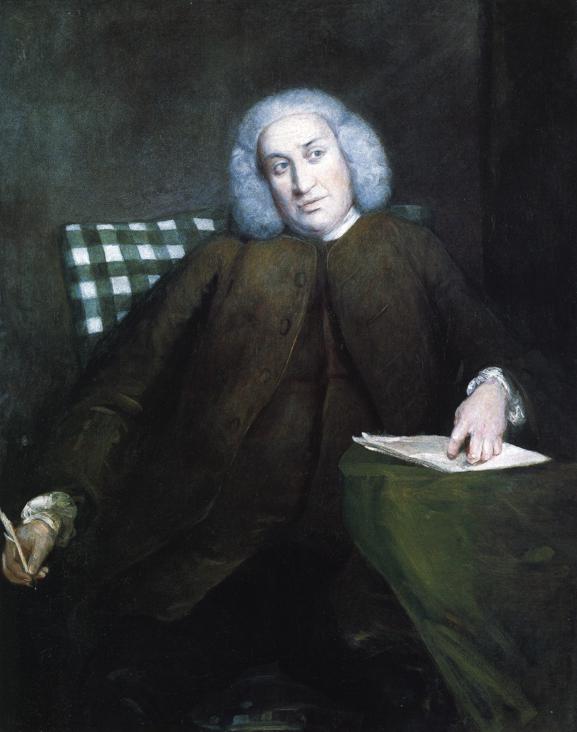
The famous portraits by Sir Joshua Reynolds in the library were sold by Hester Thrale in May 1816. Later that year it was leased to Mr. Elliott who rented the unfurnished house at a rent of £260 a year. Just before she died in 1821, Hester wrote to Madame Fanny D'Arblay 1752-1840 (née Burney), as follows…
You would not know poor Streatham Park, I have been forced to dismantle and forsake it; the expenses of the present time treble those of the moments you remember; and since giving up my Welsh estate my income is greatly diminished. I fancy this will be my last residence in the world, meaning Clifton, not Sion Row, where I only live until my house in the Crescent is ready for me … The village of Streatham is full of rich inhabitants, the common much the worse for being spotted about with houses.
The contents of the library were sold in Manchester on 17 September 1823.
Sale
In 1825 the property was sold to Michael Shepley, and the deeds of sale included this plan.
Demolition
Streatham Park was demolished and the materials sold in May 1863. The site of the estate was replaced by a residential area of housing known as Streatham Park. In 1946 the houses came under the control of the London County Council.
- 1. A walled ditch or sunken obstacle, such as a hedge, serving especially as a barrier to livestock without impairing the view or scenic appeal.
- 2. [Clifford]6, page 49, and Thraliana 12 October 1790, 17 September 1791.
- 3. Queeney.
- 4. Source: The Diary and Letters of Madame D'Arblay, Volume 1, Frances Burney.
- 5. Sunday, Aug. 23 1778. The Diary and Letters of Madame D'Arblay, Volume 1
- 6. 36 in the library, 12 in Mr Piozzi's dressing room.
 |
Henry Thrale M.P. 1724/9 - 2 May 1821 |
|---|---|
| Henry Thrale | Family tree and portraits · Homes · H. Thrale & Co. brewery · Parliamentary career · Pets · Travels · Coaching accident · Ill health · Death · Mourning tablet · Burial vault · Will · Testimonials |
| Hester Salusbury | Courtship · Marriage dowry · Marriage · Children · 13th anniversary |
| People | Father: Ralph Thrale M.P. · Arthur Murphy · Samuel Johnson · Jeremiah Crutchley · Sir John Lade · Streatham Worthies · King Louis XVI & Queen Marie Antoinette |
| Writings about | Dr Johnson's 'Own Dear Master · The Thrales of Streatham Park · Three Centuries · Thraliana |
| Signature |  |
 |
Hester Lynch Thrale née Salusbury 1741 - 2 May 1821 |
|---|---|
| Hester Thrale | Family tree and portraits · Homes · Works · Writings . Thraliana · Pets · Travels · 80th party · Criticism · Death · Obituaries |
| Henry Thrale | Courtship · Marriage dowry · Marriage · Children · 13th anniversary |
| Gabriel Piozzi | Marriage · 7th anniversary · Adopted son · Miscarried daughter |
| People | Samuel Johnson · Streatham Worthies · Proposal from Mr. Swale · King Louis XVI & Queen Marie Antoinette |
| Writings about | The Thrales of Streatham Park · Dr Johnsons Women · Intimate letters · Hester Lynch Piozzi · Dr Johnsons Women · Doctor Johnson's Mrs Thrale · By Samuel Johnson: Ode to · 35th verses · By Herbert Lawrence: Song to Hester |
| Signature |  |
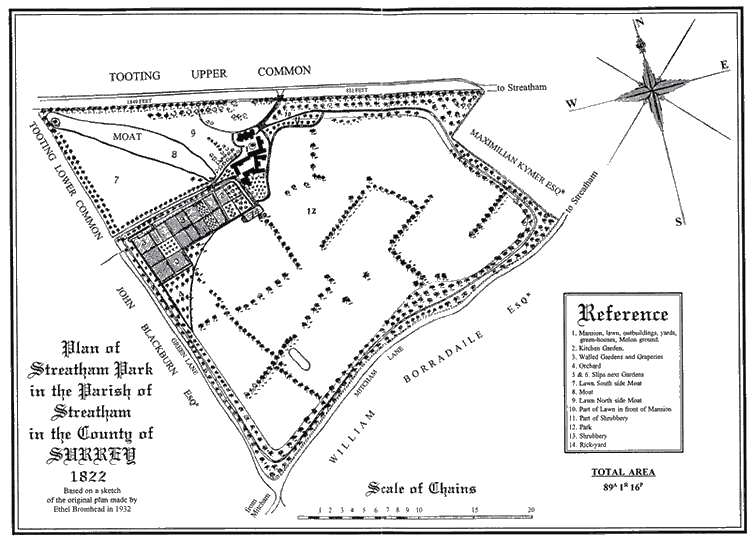
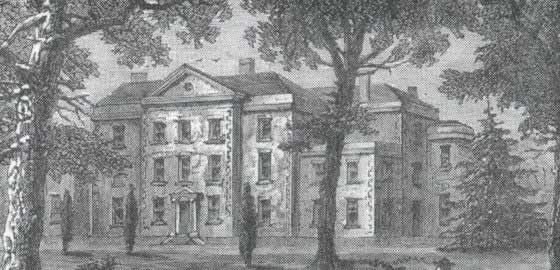
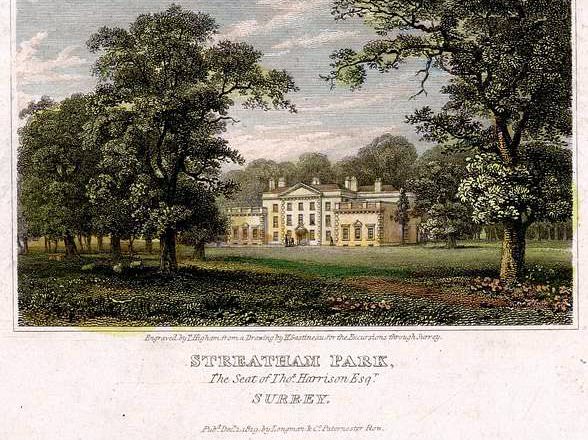

Comments
Ellis Cory (not verified)
1 August 2003 - 5:45pm
Permalink
Furzedown Community Network, Streatham
Hello, I visited Thrale.com as I am interested in local history, especially the Furzedown Ward, which includes some of the Streatham Park estate. I don't know if you have been informed, but there is now a residents association called Furzedown Community Network.
We have been in existence for four years and over that time arranged three festivals, local history talks and walks, dances and contacted the council on behalf of the residents and the area.
Our only pub, which has had various names, recently The Park Tavern, is being completely refurbished and renamed The Samuel Johnson, to maintain local links. Please get in touch if you would like further information, maybe you could come and give an insight into the areas history sometime?
Ellis Cory
David Thrale
16 August 2003 - 9:57pm
Permalink
Streatham Society too
Ellis.
I wasn't aware of the Furzedown group. Thank you for letting me know about it. I have been to a meeting of The Streatham Society and really enjoyed it
I'm not really an expert in the area, What I have on the website is just stuff that I have researched in books or information I have received by other kind visitors to Thrale.com. But if you think people would be interested in what I've found out, do let me know.
David
Thrale.com owner: David Thrale | My blog | Family motto: In cruce confido